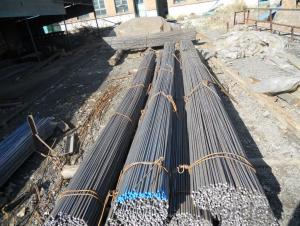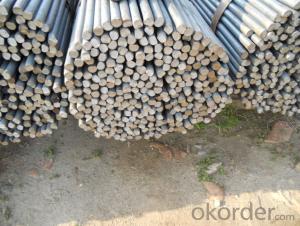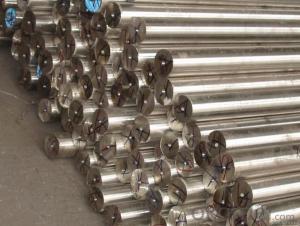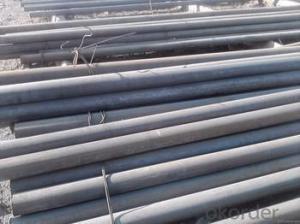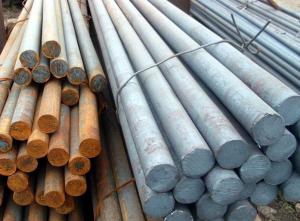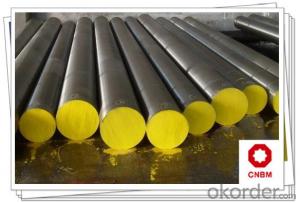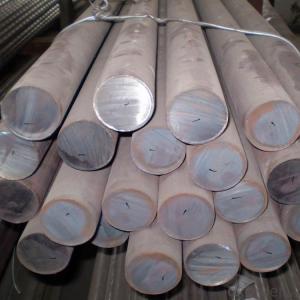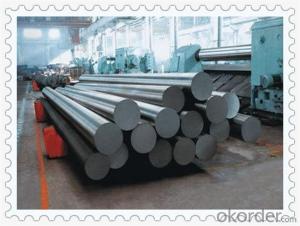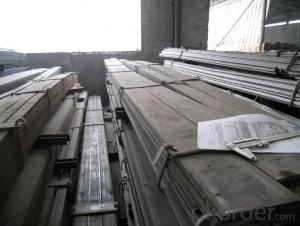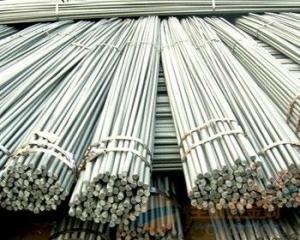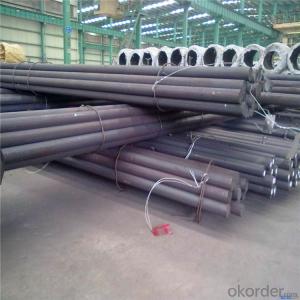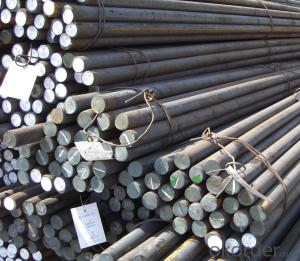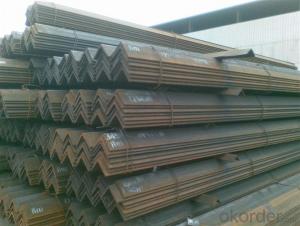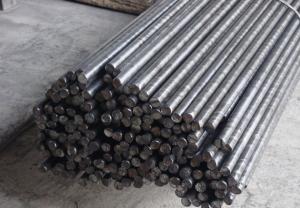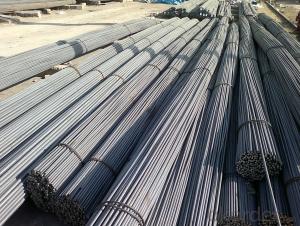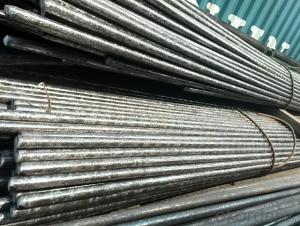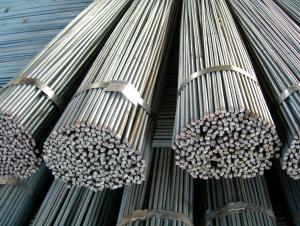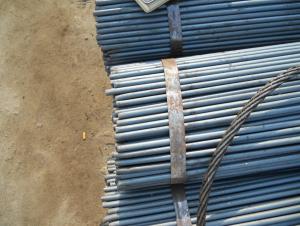high quality steel low carbon round bar JIS
- Loading Port:
- Tianjin
- Payment Terms:
- TT OR LC
- Min Order Qty:
- 5 m.t.
- Supply Capability:
- 1000 m.t./month
OKorder Service Pledge
OKorder Financial Service
You Might Also Like
Product Description:
Specifications of Wire Rod Q235:
Steel Grade: Q235, Standard: GB Diameter: 5.5mm, 6.5mm, 7mm,8mm,9mm,10mm,12mm,14mm
Diameter Tolerance:±0.3mm 6.5mm can be drawing into 2mm/8.0mm can be drawing into 3mm
Brand Name: N-RIVER Place of Origin: Hebei, China Mainland Application: construction, building etc
Chemical Composition:
Please kindly find our chemistry of our material based on Q235 as below for your information
Trademark | Rank | Chemical composition (quality score) % | |||||
C | Si | Mn | S | P | |||
| ≤ |
| ≤ | ≤ | |||
Q235 | A | 0.14-0.22 | 0.30 | 0.30-0.65 | 0.050 | 0.045 | |
Q235 | B | 0.12-0.20 | 0.30 | 0.30-0.70 | 0.045 | 0.045 | |
Trademark | Rank | Pulling Test | |||||
Bend PointΔs/Mpa | Tensile Strength | Elongation Ratioδ5% | |||||
Thickness (Diameter) /MM | Thickness (Diameter) /MM | ||||||
≤16 | 16-40 | ≤16 | 16-40 | ||||
≥ | ≥ | ||||||
Q235 | A | 235 | 225 | 375-500 | 26 | 25 | |
Q235 | B | 235 | 225 | 375-500 | 26 | 25 | |
Usage and Applications of Wire Rod Q235:
After hot-rolled the products shaped into coil and delivery as finished product, including round, square, rectangular, hexagonal and so on. Since most of the products are round, it is generally called wire rod. Carbon steel wire rod is widely used in construction and manufacturing. Carbon steel wire rod is mainly used for reinforcement of reinforced concrete and welded structure or reprocessed (roberts , nail, etc.) materials, especially used to produce wire drawing, welding electrode, nails, spring, electronic, precise machinery parts and so on.
Packaging & Delivery of Wire Rod Q235:
Packaging Detail: products are packed in coil and then shipped by container or bulk vessel
Each coil weight: 2-3MT
Delivery Detail: within 45 days after received deposit or LC.
Label: to be specified by customer, generally, each bundle has 1-2 labels
Trade terms: FOB, CFR, CIF
- Q: What are the corrosion resistance properties of steel round bars?
- Steel round bars have excellent corrosion resistance properties due to the presence of alloying elements such as chromium, nickel, and molybdenum. These elements form a protective oxide layer on the surface of the steel, which prevents the underlying metal from coming into contact with corrosive substances. The chromium in steel round bars reacts with oxygen in the air to form a thin, invisible layer of chromium oxide. This layer acts as a barrier, protecting the steel from further oxidation and corrosion. Nickel and molybdenum enhance the corrosion resistance of steel by increasing its resistance to pitting, crevice corrosion, and chloride-induced stress corrosion cracking. In addition to alloying elements, the manufacturing process can also affect the corrosion resistance of steel round bars. For instance, stainless steel round bars are often passivated, which involves the removal of free iron and other contaminants from the surface. Passivation enhances the corrosion resistance of the steel by creating a clean and inert surface that is less prone to corrosion. Overall, steel round bars are known for their excellent corrosion resistance properties, making them suitable for a wide range of applications in various industries, including construction, marine, automotive, and aerospace.
- Q: What is the difference between hot working and cold working of steel round bars?
- Hot working and cold working are two different methods used to shape and manipulate steel round bars. Hot working refers to the process of shaping steel at elevated temperatures, typically above the recrystallization temperature of the steel. This allows for the material to be more malleable and easier to shape. Hot working processes include forging, rolling, and extrusion. One of the main advantages of hot working is that it allows for the material to be formed into complex shapes and sizes with minimal force or energy. It also helps to refine the grain structure of the steel, improving its mechanical properties such as strength and toughness. However, hot working can cause oxidation and scale formation on the surface of the steel, which may require additional surface treatments or cleaning. Cold working, on the other hand, involves shaping steel at room temperature or below its recrystallization temperature. Cold working processes include bending, drawing, and cold rolling. Unlike hot working, cold working does not require heating the steel, which can save energy and reduce production costs. It also produces a smoother surface finish and tighter tolerances compared to hot working. Cold working can increase the hardness and strength of the steel, making it suitable for applications that require higher mechanical properties. However, cold working can also make the steel more brittle and prone to cracking. In summary, the main difference between hot working and cold working of steel round bars is the temperature at which the shaping process takes place. Hot working is done at elevated temperatures, allowing for easier shaping and improved mechanical properties, while cold working is done at room temperature or below, resulting in tighter tolerances and increased hardness. The choice between hot working and cold working depends on the desired properties and characteristics of the final product.
- Q: How do you prevent steel round bars from rusting?
- To prevent steel round bars from rusting, there are several effective methods you can employ: 1. Apply a protective coating: One of the most common ways to prevent rust on steel round bars is to apply a protective coating. This can be done by using paint, epoxy, or other corrosion-resistant coatings. The coating acts as a barrier between the steel and moisture, preventing oxidation and rust formation. 2. Keep the bars dry: Moisture is a major catalyst for rust formation. Therefore, it is important to keep the steel round bars dry at all times. Store them in a dry location, away from water or humidity. If the bars come in contact with water, make sure to dry them thoroughly to prevent any residual moisture from causing rust. 3. Implement proper ventilation: Adequate ventilation helps in reducing moisture levels in the air, which in turn prevents rusting. Ensure that the storage area or facility where the steel round bars are kept has good airflow and is well-ventilated. This will minimize the chances of moisture buildup and rust formation. 4. Apply corrosion inhibitors: Corrosion inhibitors are chemical compounds that can be applied to the surface of steel round bars to prevent rust. These inhibitors work by forming a protective layer on the steel, inhibiting the oxidation process. There are various types of corrosion inhibitors available, so choose the one that is suitable for your specific application. 5. Regular maintenance and inspection: Regularly inspect the steel round bars for any signs of rust or damage. If any rust spots are found, remove them immediately using a wire brush or sandpaper and apply a fresh coat of protective coating. Additionally, ensure that the bars are stored in a clean and dry environment to minimize the risk of rust formation. By following these preventive measures, you can significantly reduce the chances of steel round bars rusting and prolong their lifespan.
- Q: Can steel round bars be painted?
- Yes, steel round bars can be painted. Painting steel round bars can help protect them from corrosion and enhance their appearance. However, before painting, the surface of the steel round bars should be properly prepared by cleaning, degreasing, and removing any rust or mill scale. This can be done using methods such as sandblasting, wire brushing, or chemical cleaning. Once the surface is adequately prepared, a primer specifically designed for steel should be applied to promote better adhesion of the paint. Finally, the desired paint can be applied to the steel round bars using brushes, rollers, or spray equipment. It is important to choose a paint that is suitable for outdoor use and provides sufficient protection against harsh weather conditions. Regular maintenance and periodic repainting may be required to ensure the longevity and durability of the painted steel round bars.
- Q: What are the different surface defects that can be found in steel round bars?
- Some common surface defects that can be found in steel round bars include scratches, pits, cracks, scale, and decarburization.
- Q: Cold drawn steel wire is a round bar or thread steel in Construction Engineering?
- Cold drawn steel wire should be the same as round steel and thread steel! Their forming process and the meaning of the place used are different, and the quota is also different, cold drawn steel wire is cold drawn steel wire, strictly speaking, there is no mix together.
- Q: What are the advantages of using aluminum-magnesium alloy steel round bars?
- There are several advantages of using aluminum-magnesium alloy steel round bars: 1. Lightweight: Aluminum-magnesium alloy steel has a lower density compared to traditional steel, making it a lightweight material. This characteristic is advantageous in applications where weight reduction is crucial, such as in aerospace or automotive industries. It allows for improved fuel efficiency and increased payload capacity. 2. Corrosion resistance: Aluminum-magnesium alloy steel has excellent corrosion resistance properties. The addition of magnesium enhances the alloy's ability to withstand harsh environments, including exposure to moisture, chemicals, and saltwater. This makes it an ideal choice for marine applications or in areas with high humidity or corrosive atmospheres. 3. High strength-to-weight ratio: Despite its lightweight nature, aluminum-magnesium alloy steel exhibits high strength. It offers a superior strength-to-weight ratio compared to other materials, allowing for the construction of sturdy and durable structures. This advantage is particularly valuable in applications such as construction, where both strength and weight are important factors. 4. Excellent machinability: Aluminum-magnesium alloy steel is easy to machine, making it suitable for a wide range of fabrication processes. It can be easily cut, drilled, and welded, allowing for efficient manufacturing and assembly. This ease of machining not only saves time and costs but also enables complex designs and customization. 5. Thermal conductivity: Aluminum-magnesium alloy steel has excellent thermal conductivity, allowing for efficient heat transfer. This property is valuable in various applications, including heat exchangers, cooling systems, and electrical conductors. It helps dissipate heat quickly, preventing overheating and improving overall performance. 6. Recyclability: Aluminum-magnesium alloy steel is highly recyclable, making it an environmentally friendly choice. It can be easily melted down and reused, reducing the demand for raw materials and minimizing waste. Recycling aluminum-magnesium alloy steel requires significantly less energy compared to primary production, making it a sustainable option. Overall, the advantages of using aluminum-magnesium alloy steel round bars make it a versatile and cost-effective material for a wide range of applications. Its lightweight nature, corrosion resistance, high strength-to-weight ratio, excellent machinability, thermal conductivity, and recyclability make it a preferred choice in industries where these properties are essential.
- Q: Are steel round bars suitable for heat exchanger applications?
- Heat exchanger applications can benefit from the use of steel round bars. Steel is a widely utilized material in various industries, including heat exchangers, because of its exceptional thermal conductivity and strength. The round shape of the bars simplifies their fabrication and installation in heat exchanger systems. For applications requiring heat exchange, like power plants, chemical processes, HVAC systems, and refrigeration units, steel round bars are ideal as they efficiently transfer heat between two fluids. Moreover, steel provides good corrosion resistance, which is crucial for heat exchangers that encounter different fluids. By implementing proper design and material selection, steel round bars can reliably withstand high temperatures and pressure differentials in heat exchanger applications.
- Q: How can steel round bars be protected against rust?
- Steel round bars can be protected against rust through various methods. One common way is by applying a protective coating, such as paint or a rust-resistant primer. This coating acts as a barrier between the steel and the surrounding environment, preventing moisture and oxygen from coming into contact with the metal surface. Another effective method is to galvanize the steel round bars. Galvanization involves immersing the steel in a bath of molten zinc, which forms a protective layer on the surface. This zinc coating acts as a sacrificial barrier, meaning that even if it gets scratched or damaged, it will still protect the underlying steel. Regular maintenance is crucial in preventing rust on steel round bars. This includes keeping the bars clean and dry, as moisture is a major catalyst for rust formation. Regularly inspecting the bars for any signs of rust or damage and promptly addressing them is also important in preventing further corrosion. Furthermore, storing the steel round bars in a dry and well-ventilated area can help reduce the chances of rusting. If possible, keeping the bars elevated off the ground or using a moisture-absorbing material, such as silica gel packets, can further protect against moisture buildup. Lastly, utilizing corrosion inhibitors or rust-preventative oils can provide an additional layer of protection for steel round bars. These substances create a thin film on the surface that inhibits the formation of rust. By employing these methods, steel round bars can be effectively protected against rust, ensuring their longevity and maintaining their structural integrity.
- Q: What are the tolerance levels for steel round bars?
- Tolerance levels for steel round bars vary depending on the specific application and industry standards. Steel round bars are typically produced with tight dimensional tolerances to ensure their precise diameter, straightness, and surface finish. Common tolerance levels for steel round bars include diameter tolerances, straightness tolerances, and surface finish tolerances. Diameter tolerances specify the acceptable range of deviation from the nominal diameter of the round bar. This tolerance is usually expressed as a plus or minus value, such as +/- 0.005 inches. The specific tolerance will depend on the size and type of steel round bar being produced, as well as the requirements of the application. Straightness tolerances refer to the allowable amount of deviation from a perfectly straight line along the length of the round bar. This tolerance is typically expressed in terms of the maximum distance between the round bar and a straight edge placed along its length. For example, a straightness tolerance of 0.030 inches per foot means that a one-foot section of the round bar can deviate up to 0.030 inches from a straight line. Surface finish tolerances specify the acceptable level of imperfections or irregularities on the surface of the round bar. This tolerance is often expressed in terms of roughness average (Ra) or roughness peak (Rz) values. The specific tolerance will depend on the desired surface finish and the application requirements. It is important to note that tolerance levels may also be subject to industry-specific standards, such as those set by organizations like the American Society for Testing and Materials (ASTM) or the International Organization for Standardization (ISO). These standards provide guidelines and specifications for various steel products, including round bars, to ensure consistent quality and performance. Ultimately, determining the tolerance levels for steel round bars involves considering the specific application requirements, industry standards, and the capabilities of the manufacturing process.
Send your message to us
high quality steel low carbon round bar JIS
- Loading Port:
- Tianjin
- Payment Terms:
- TT OR LC
- Min Order Qty:
- 5 m.t.
- Supply Capability:
- 1000 m.t./month
OKorder Service Pledge
OKorder Financial Service
Similar products
Hot products
Hot Searches
Related keywords
